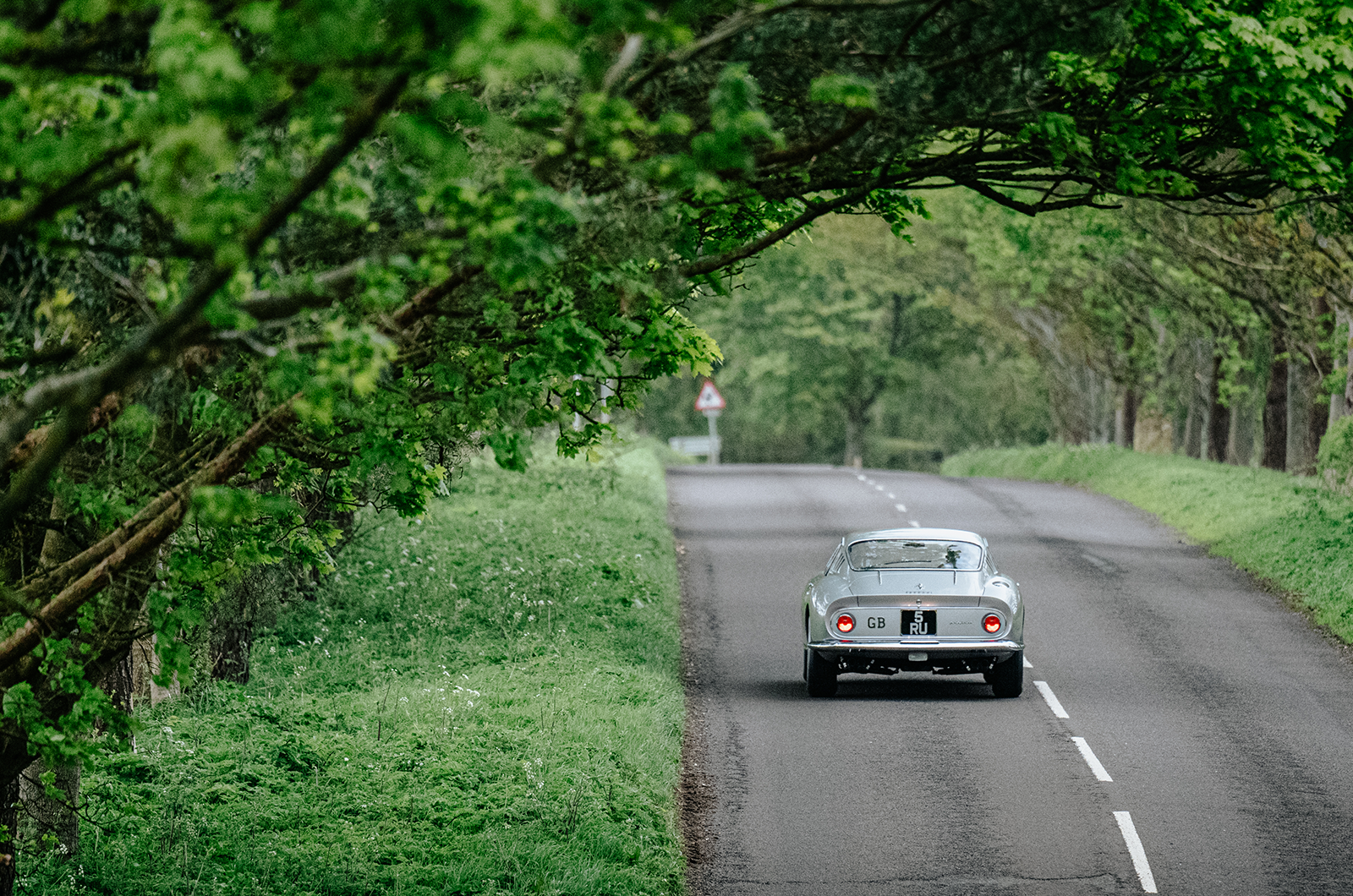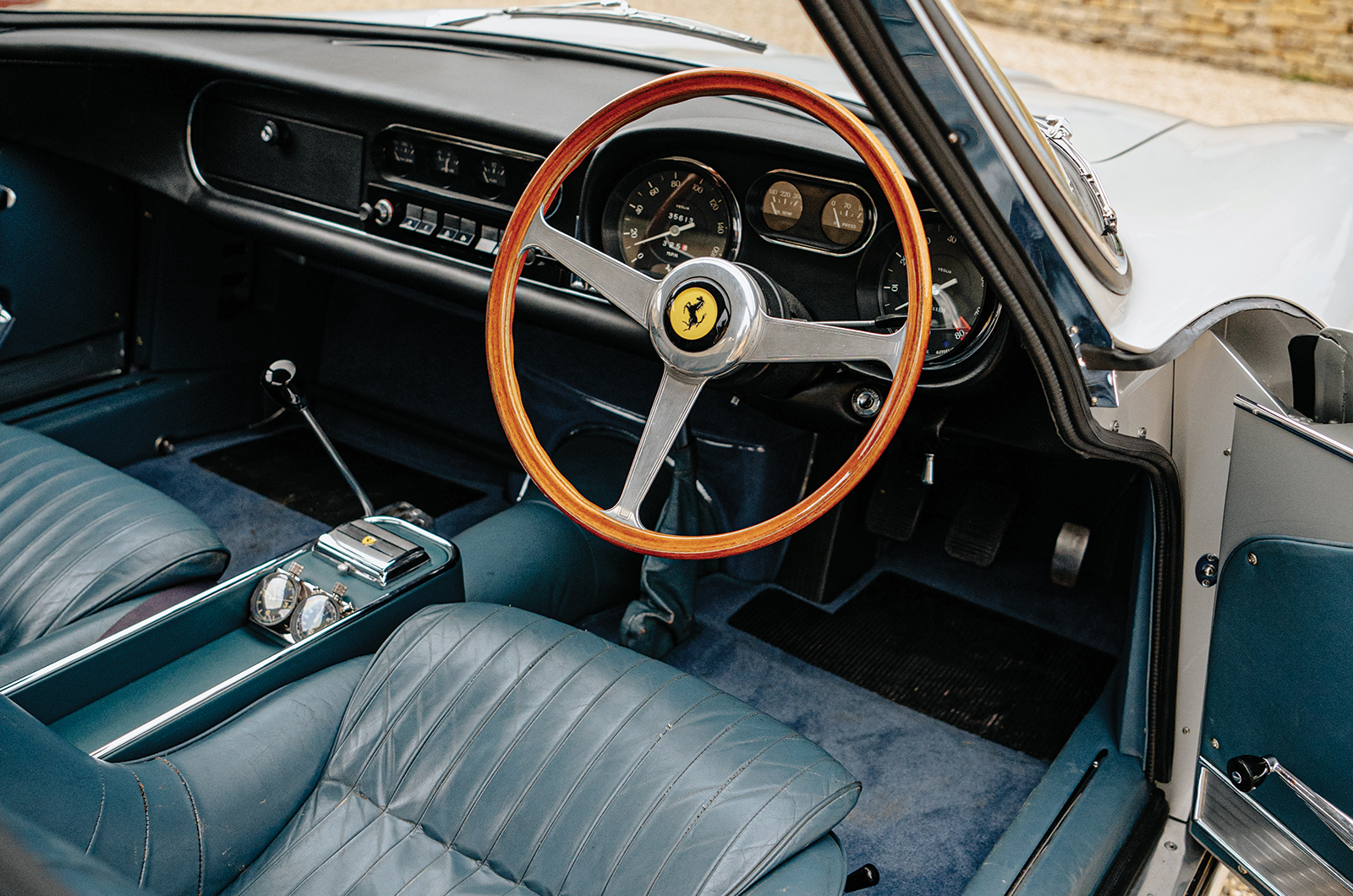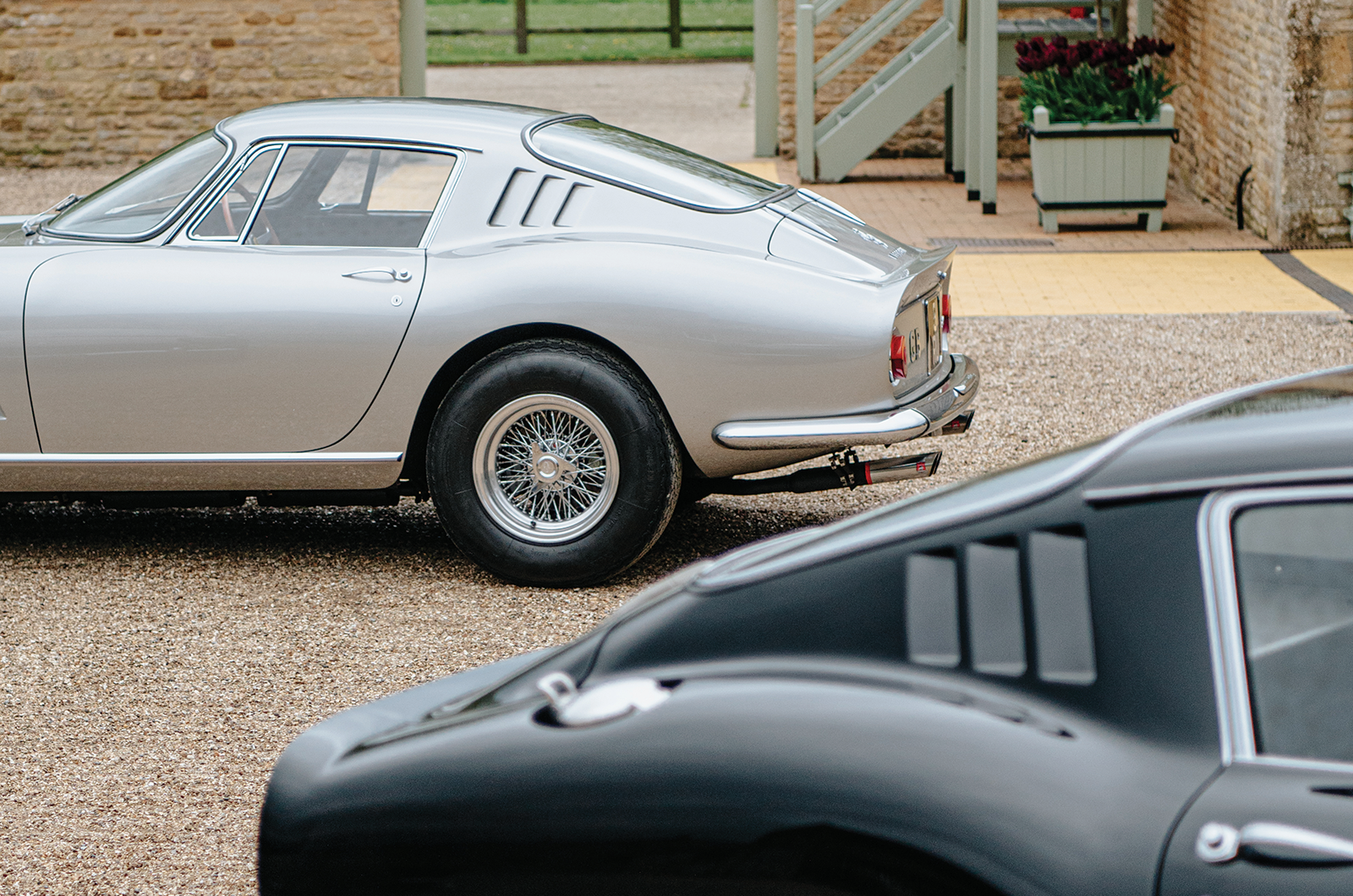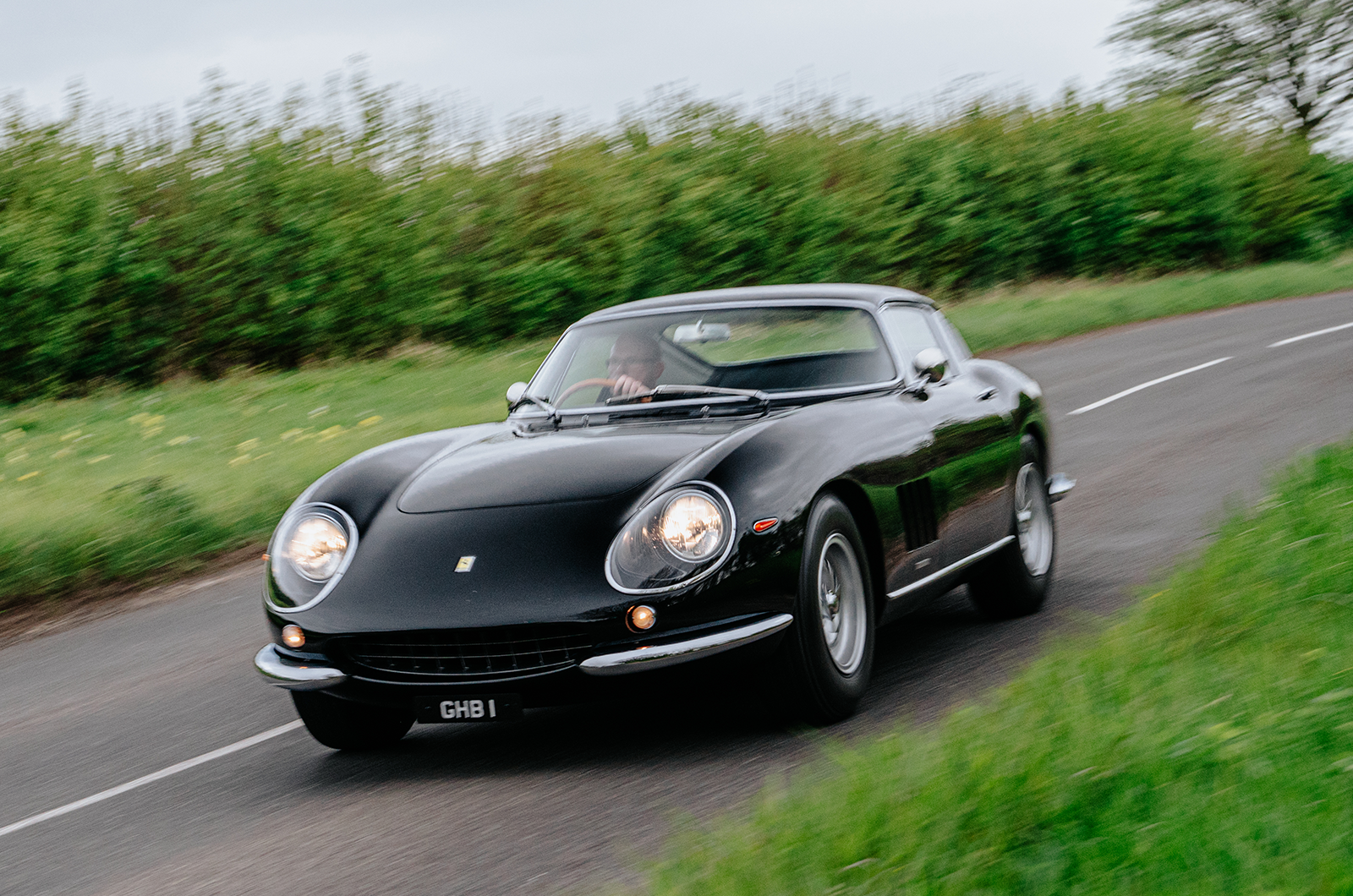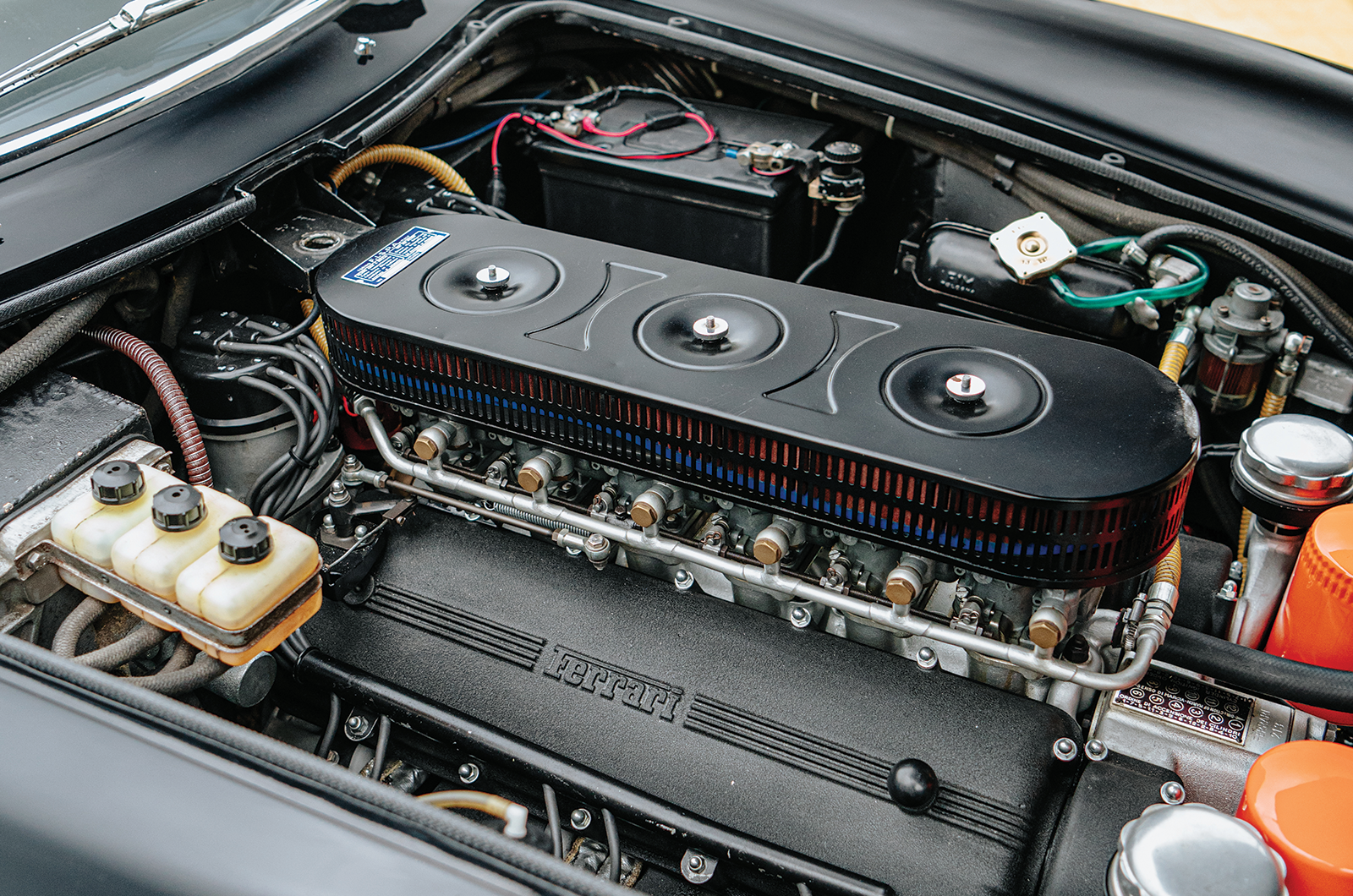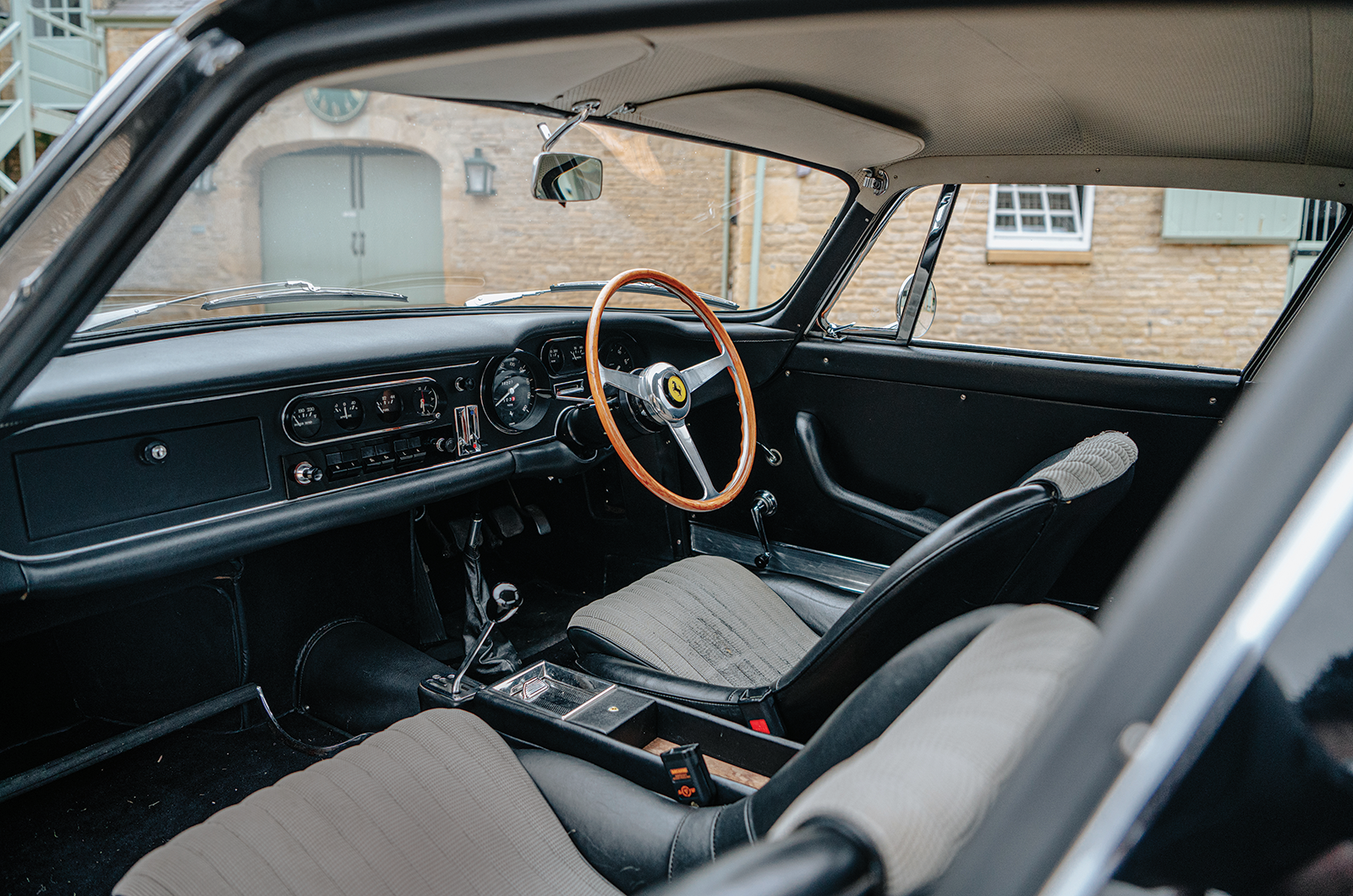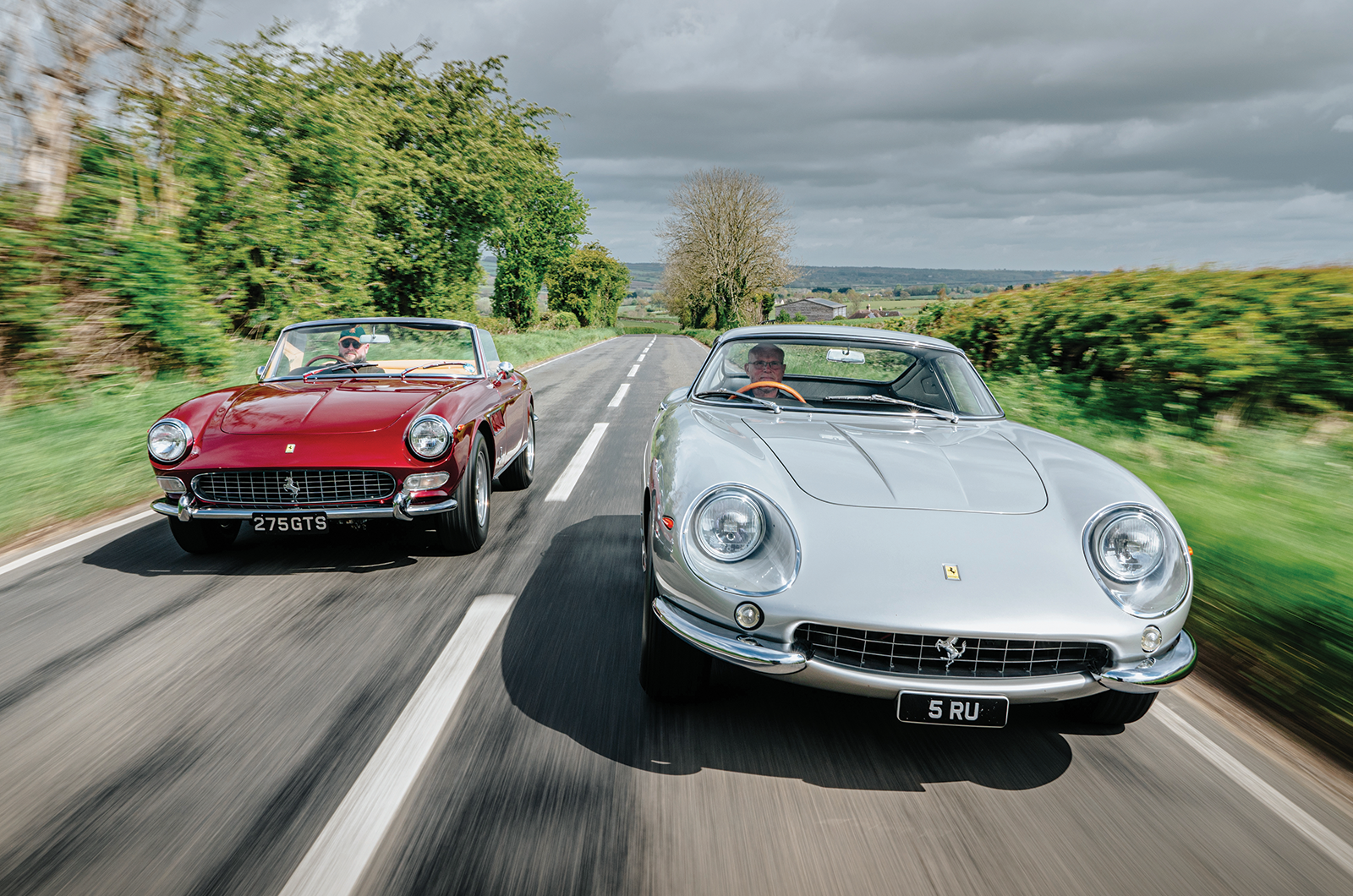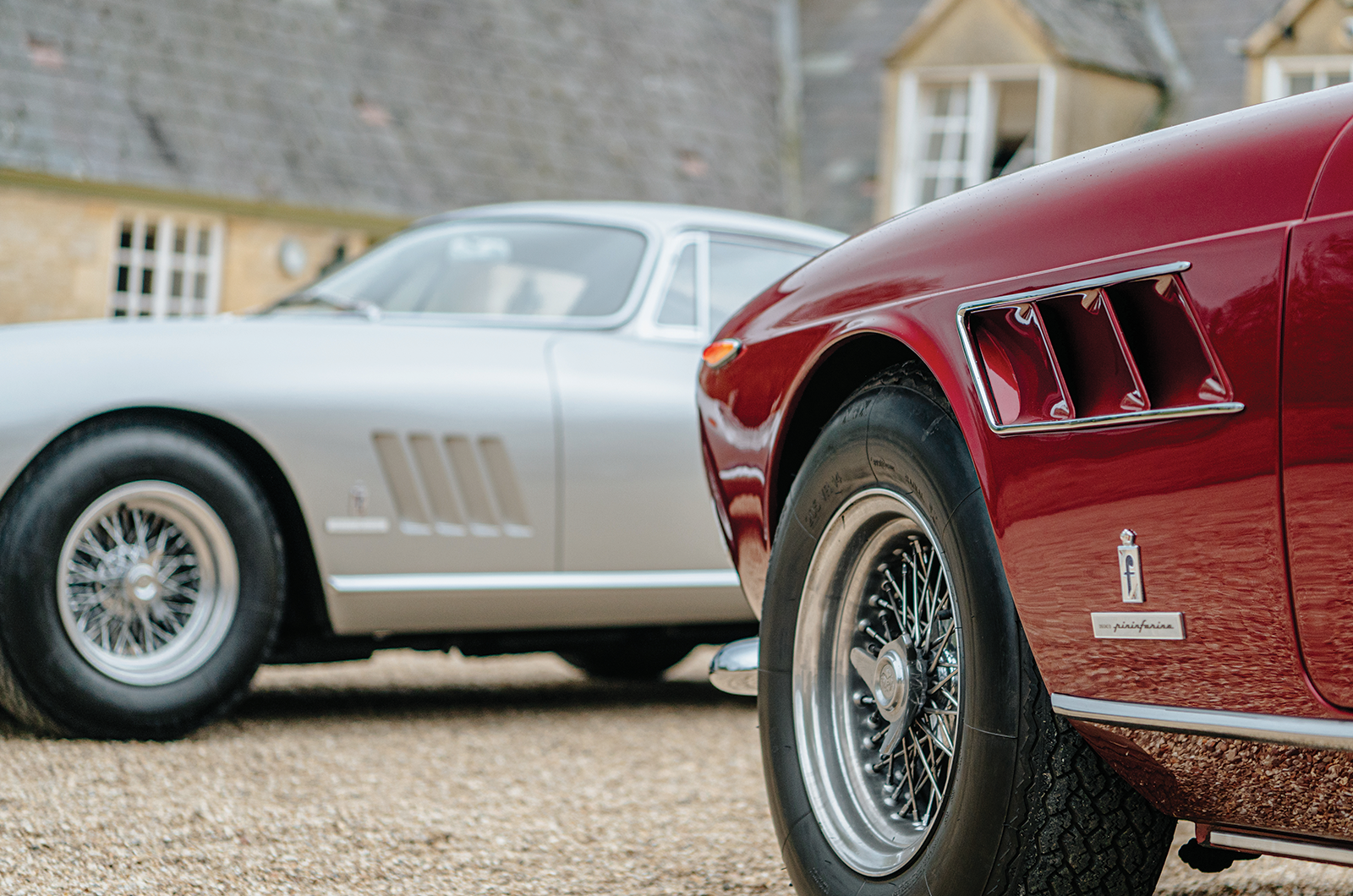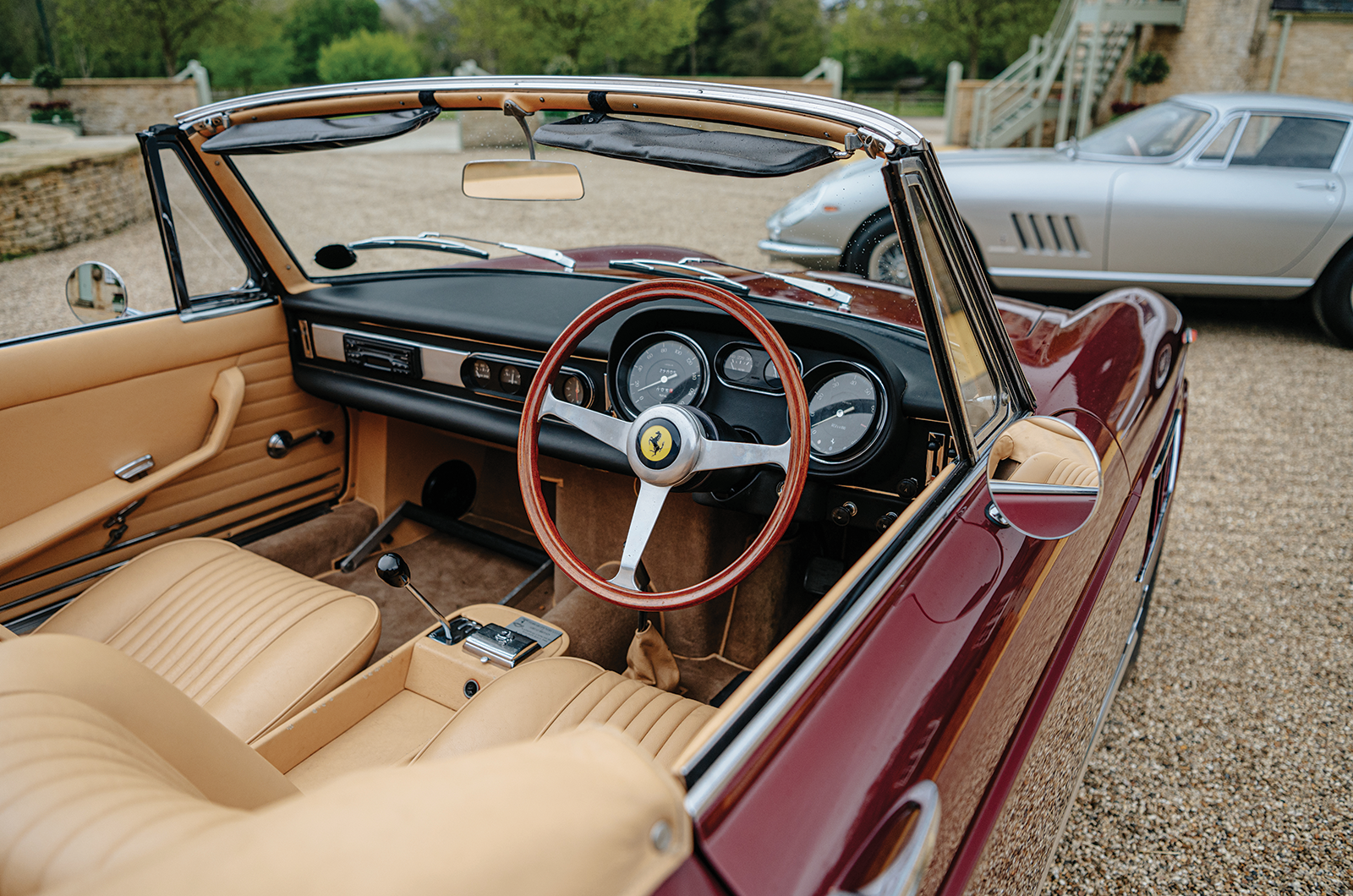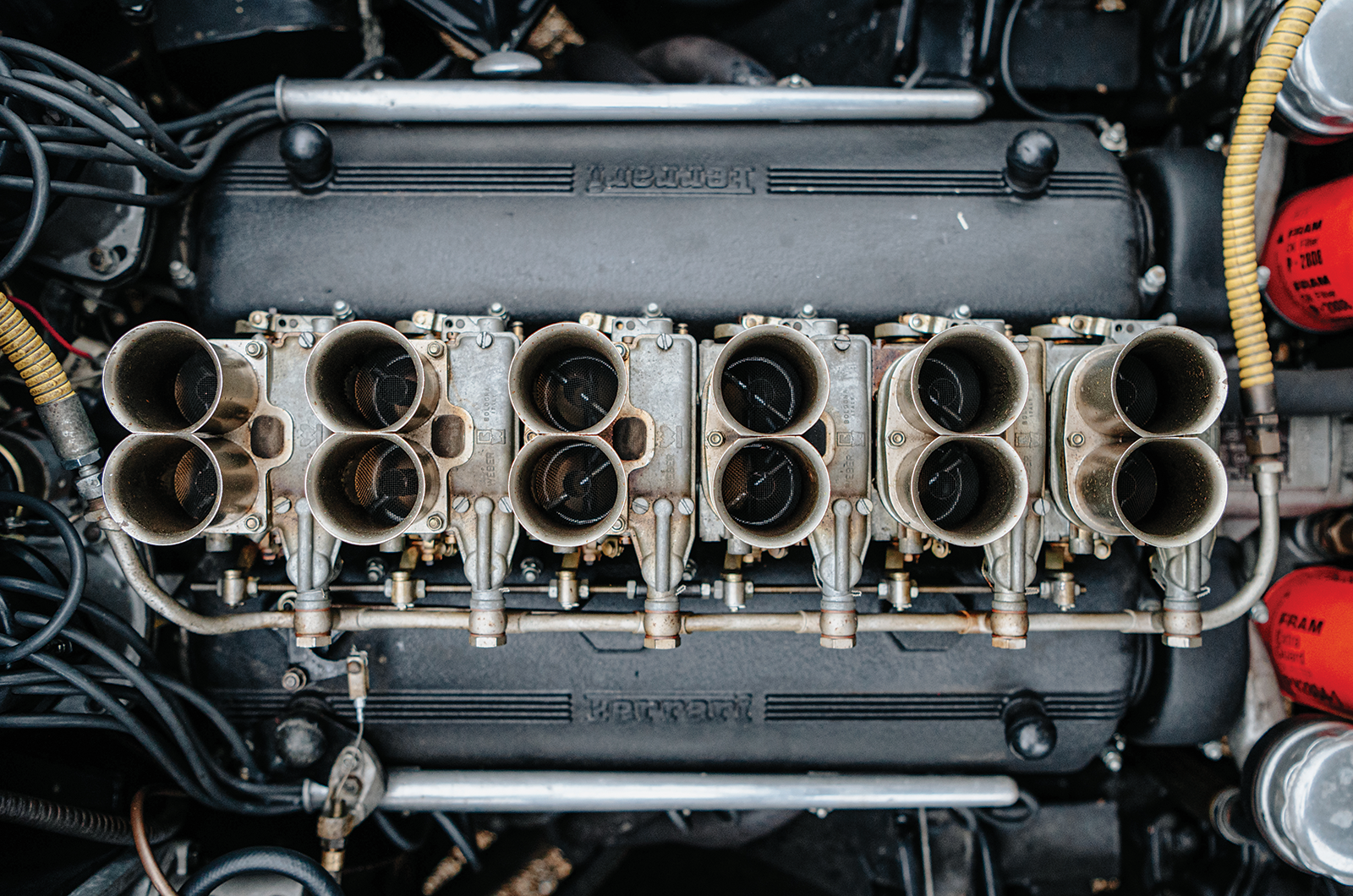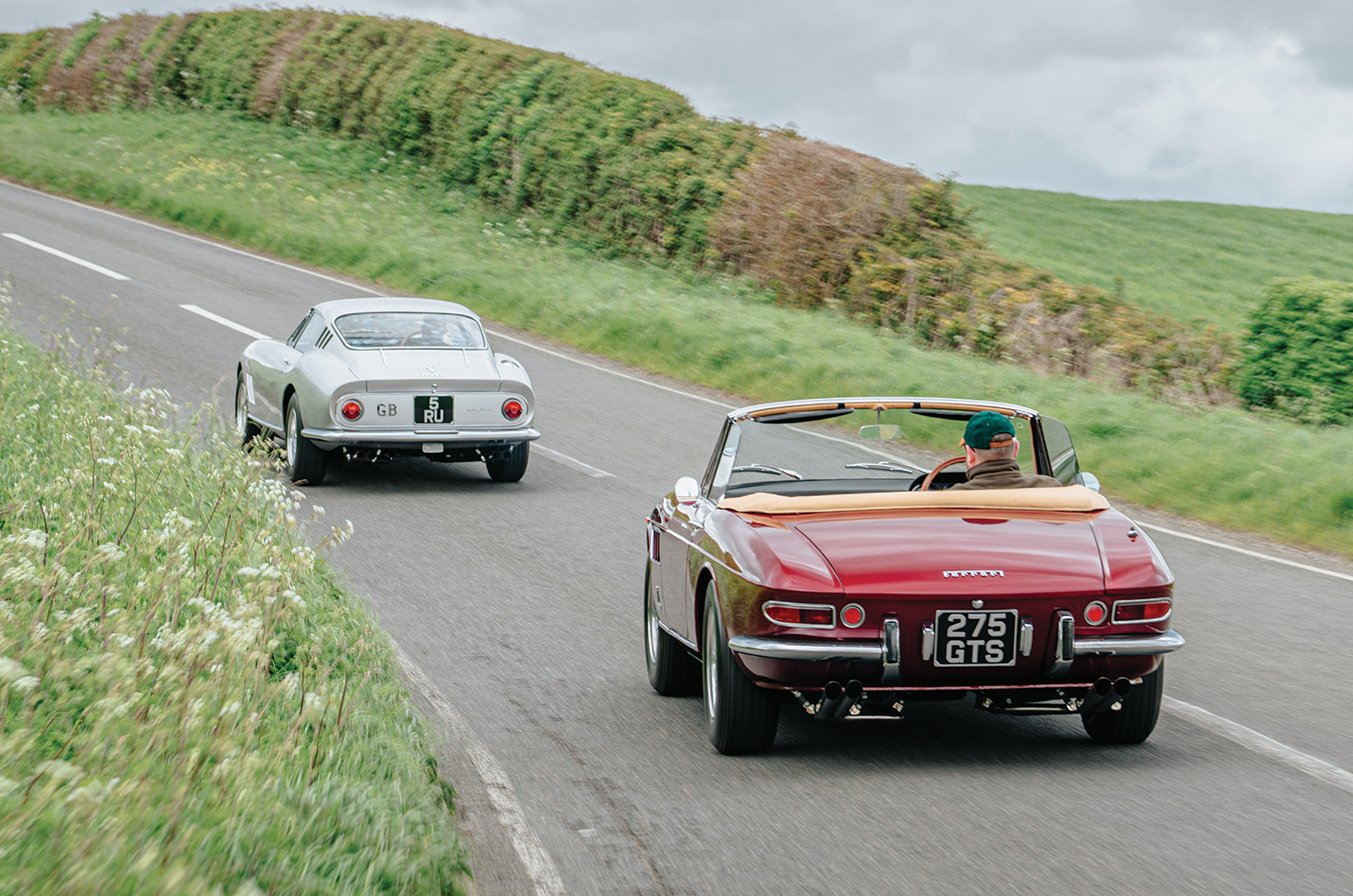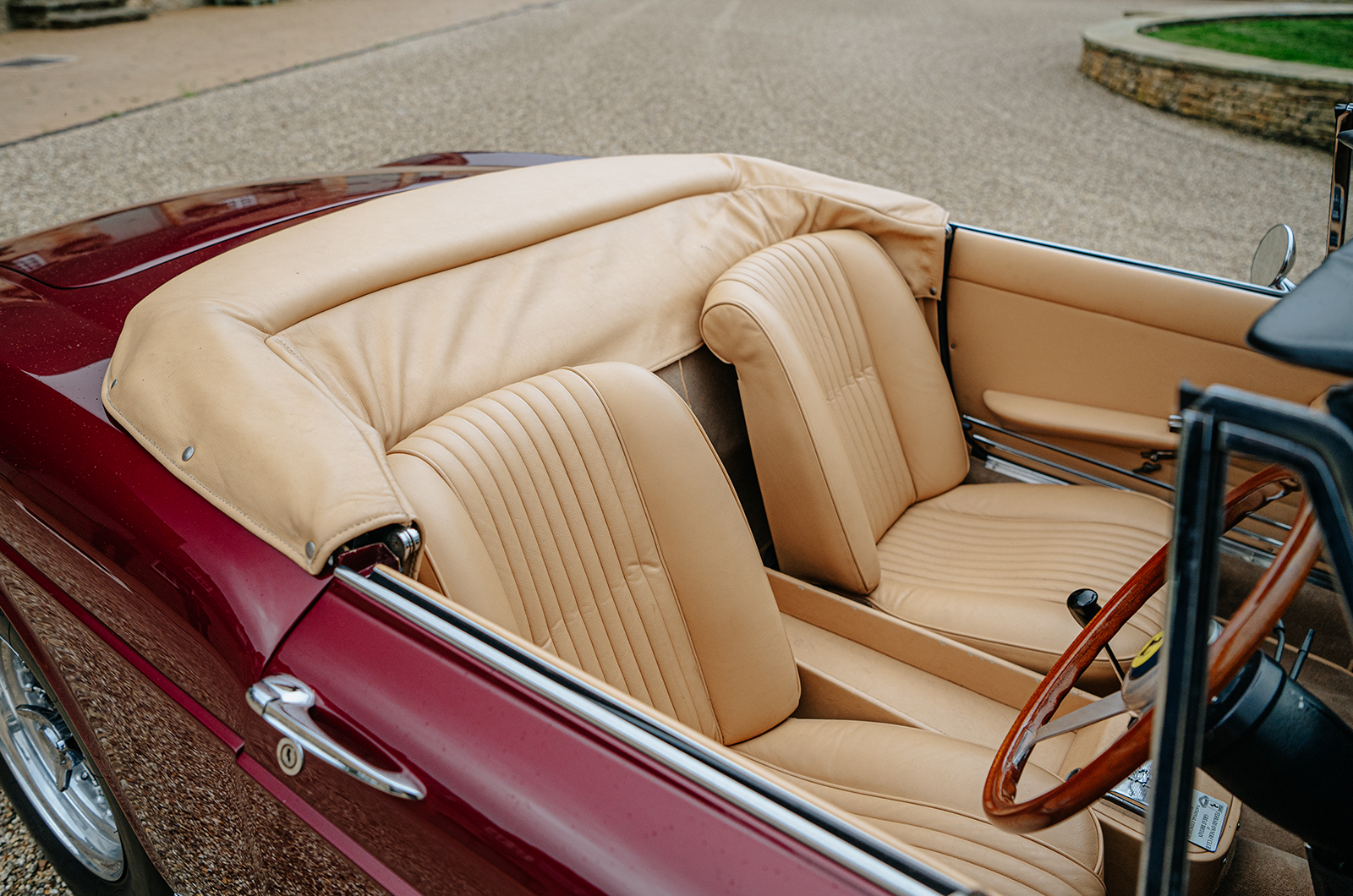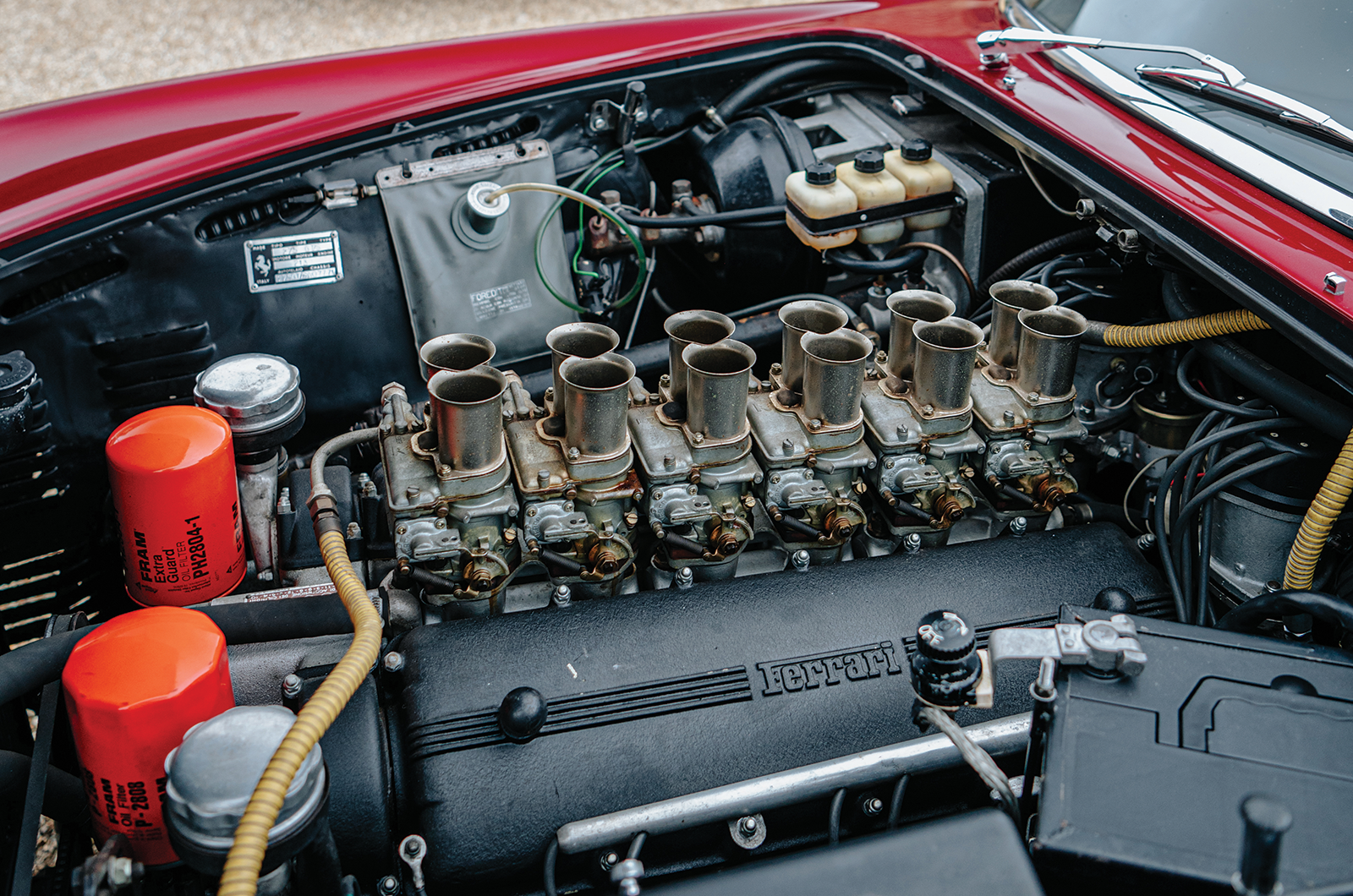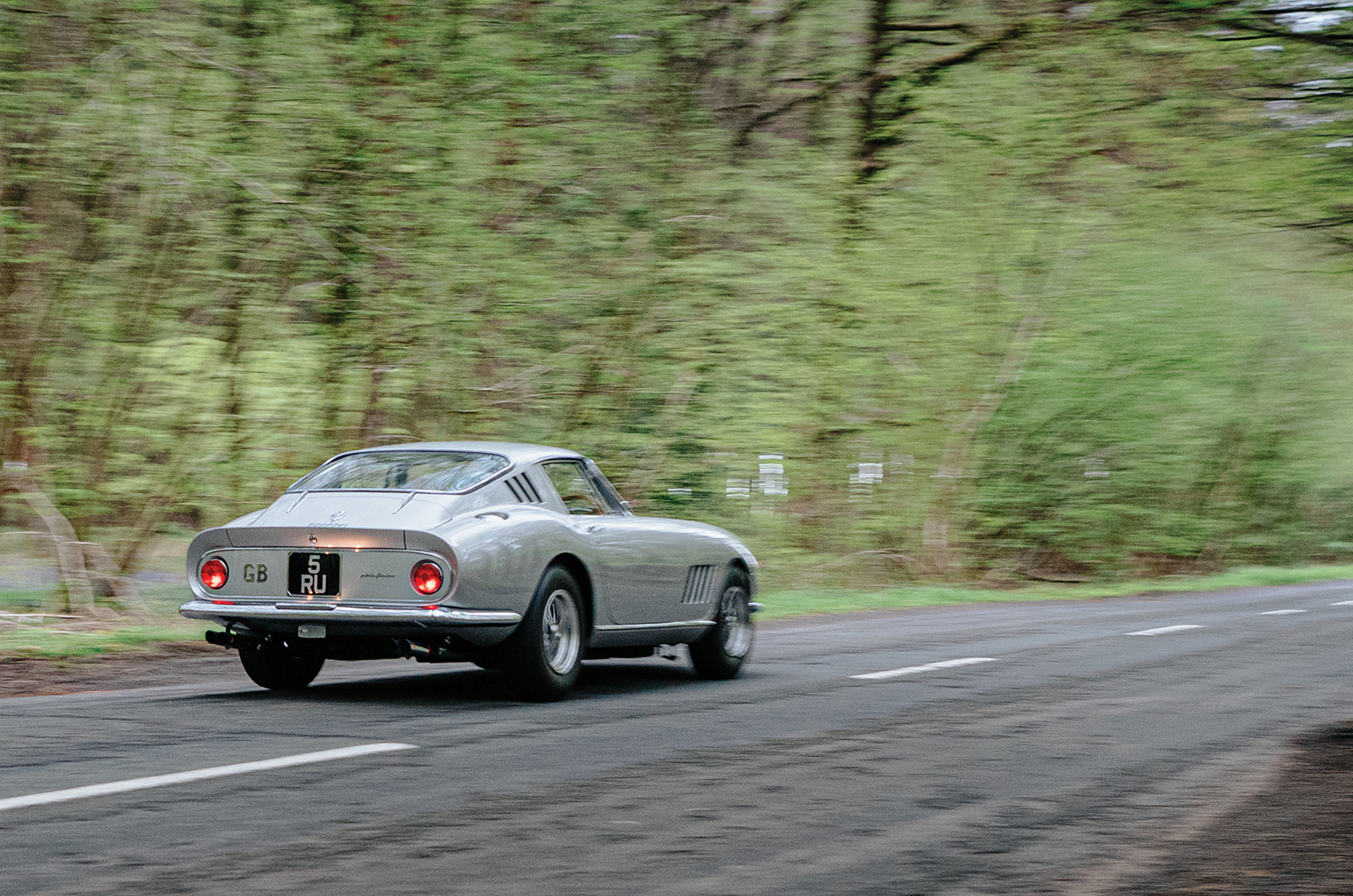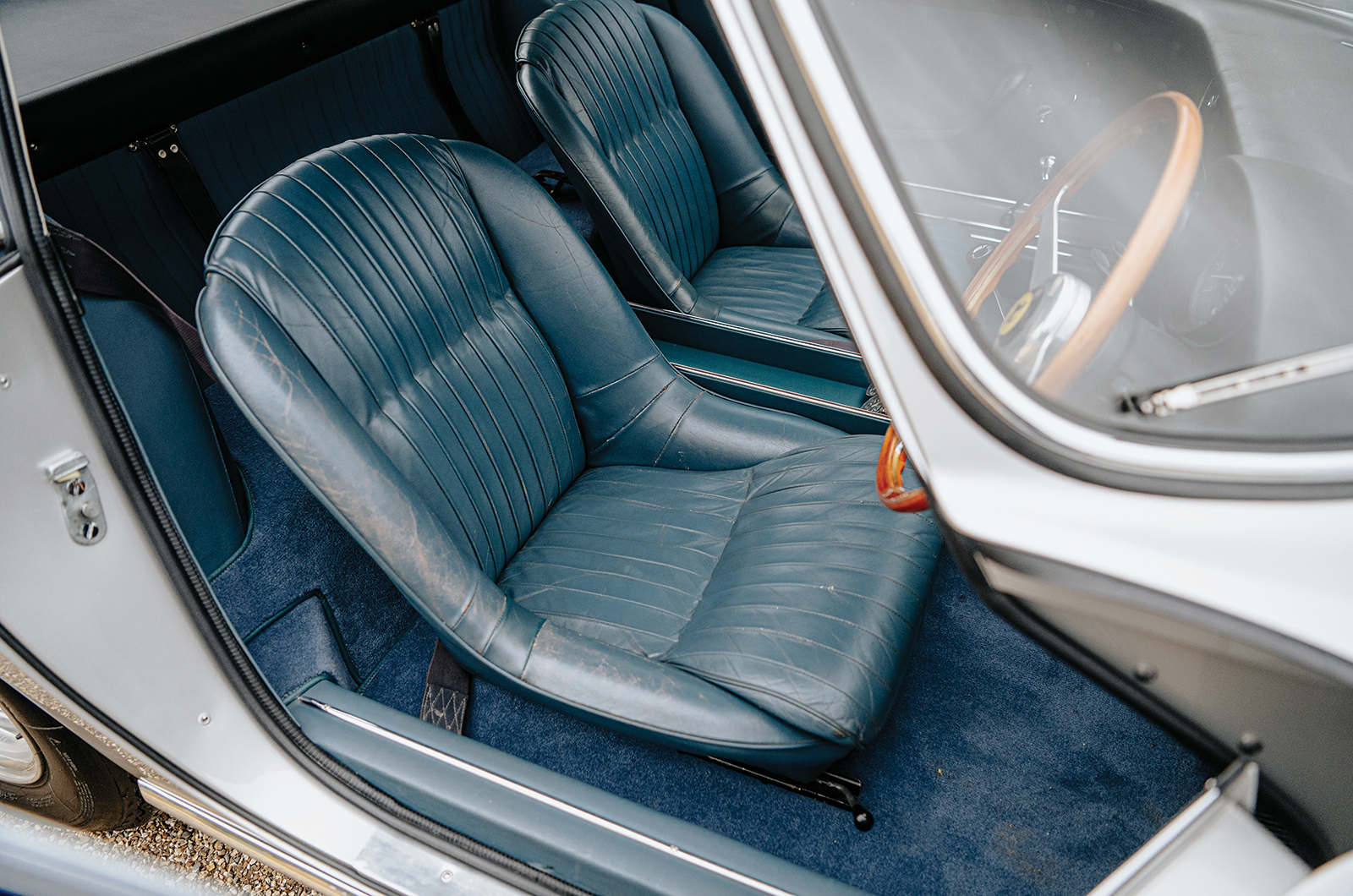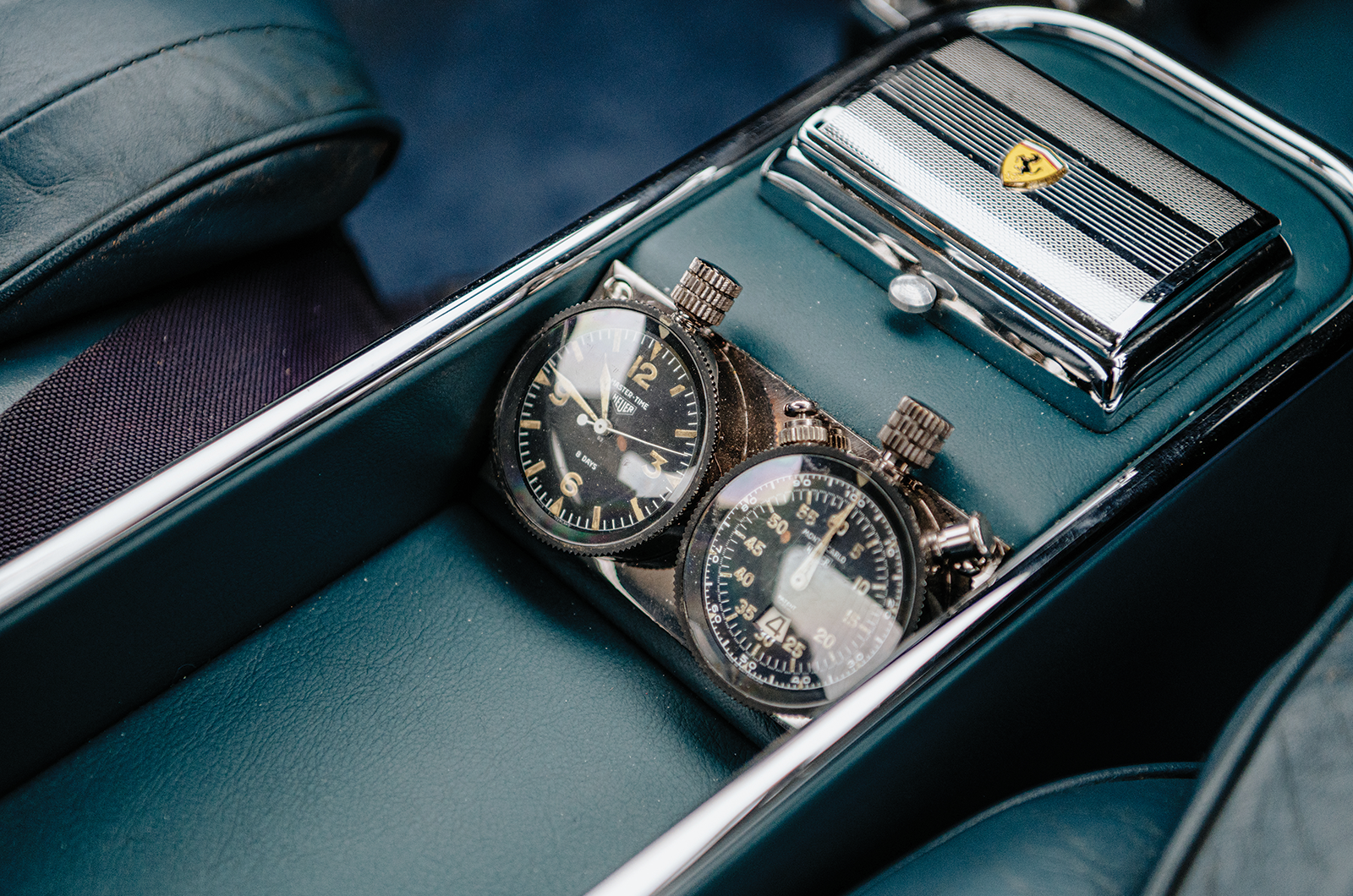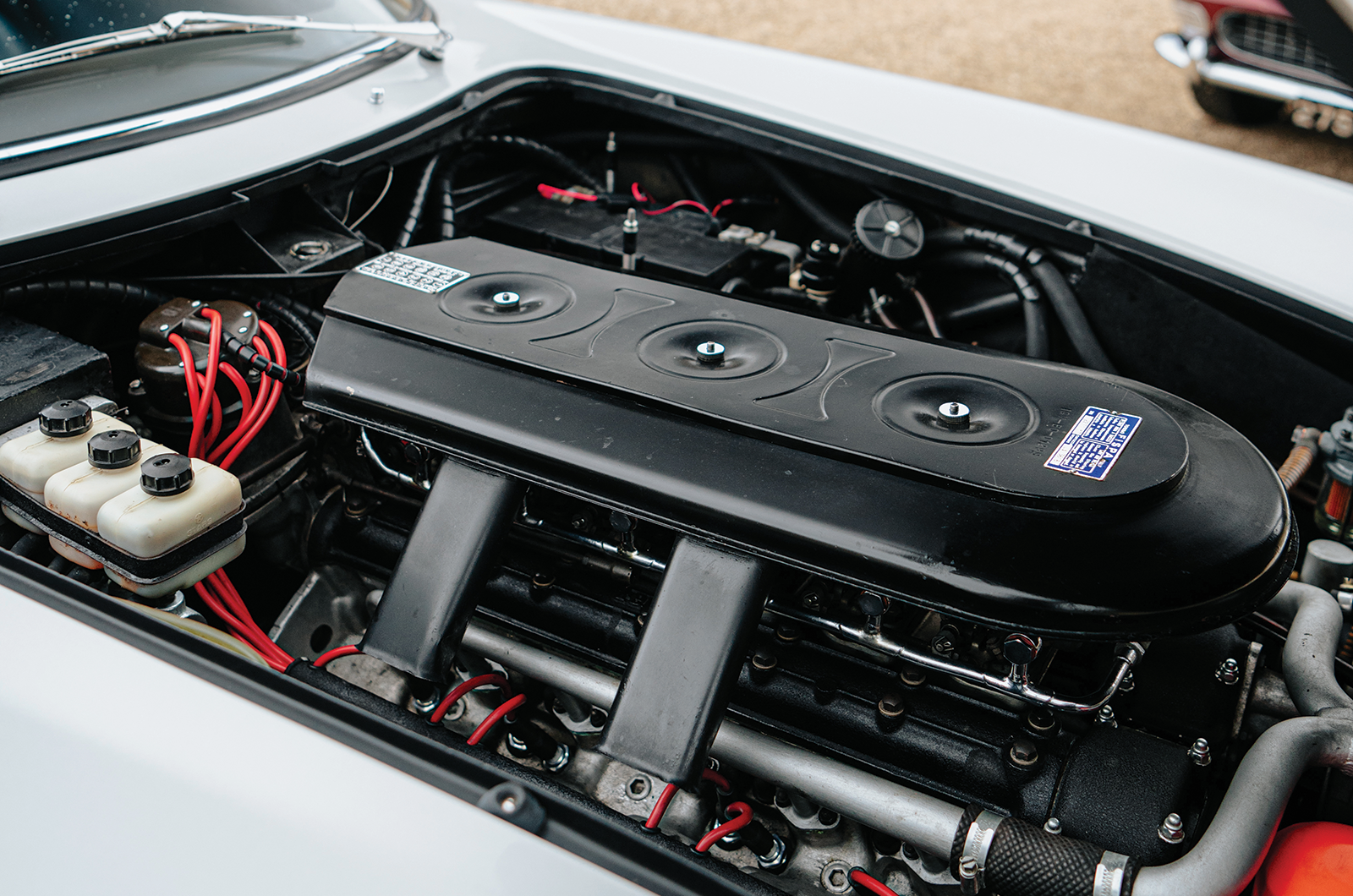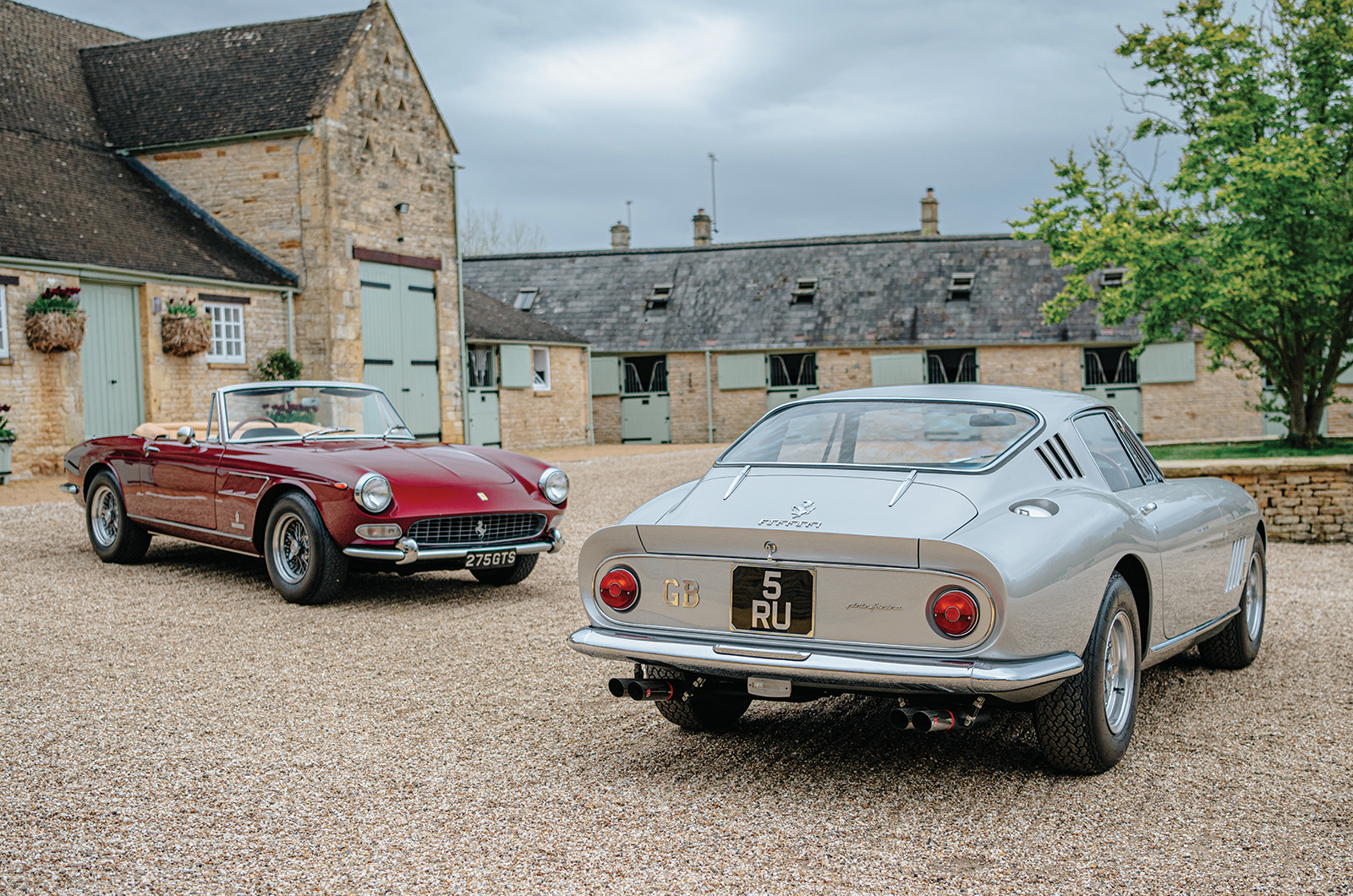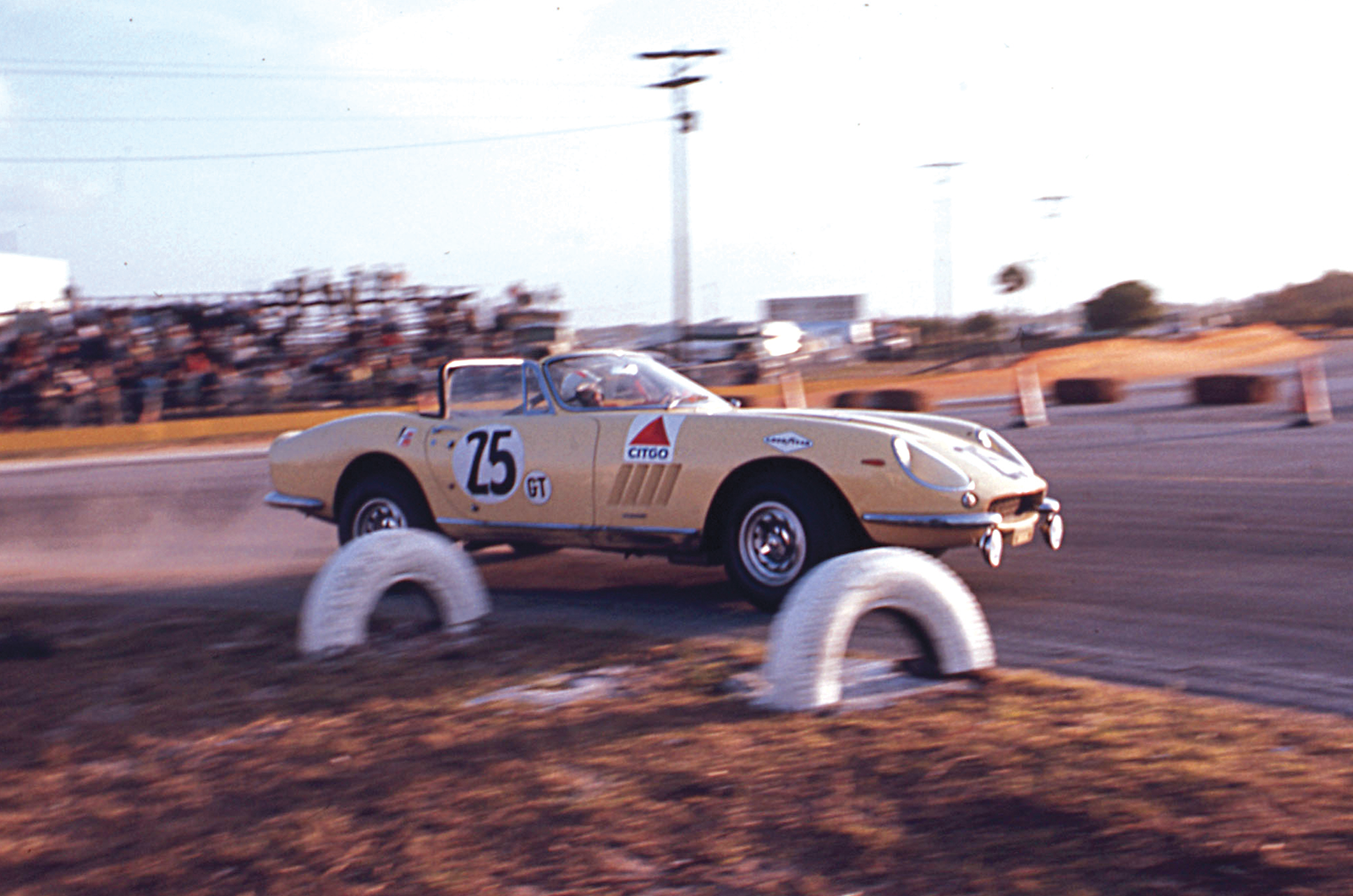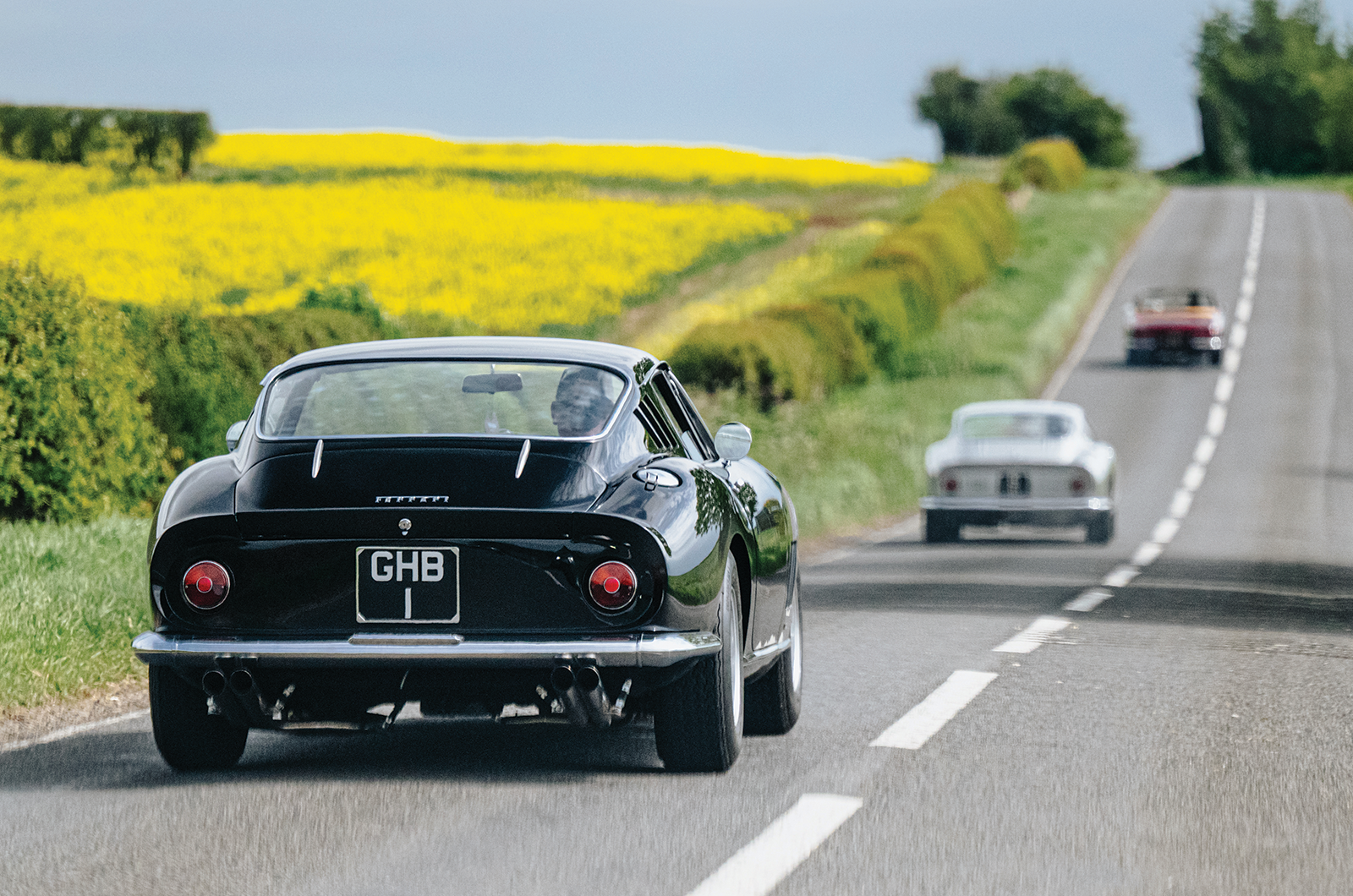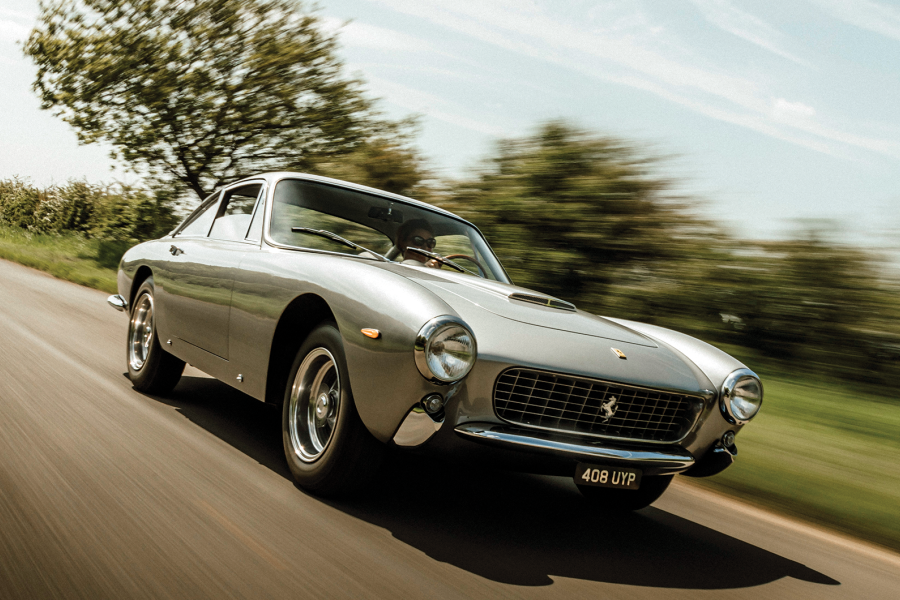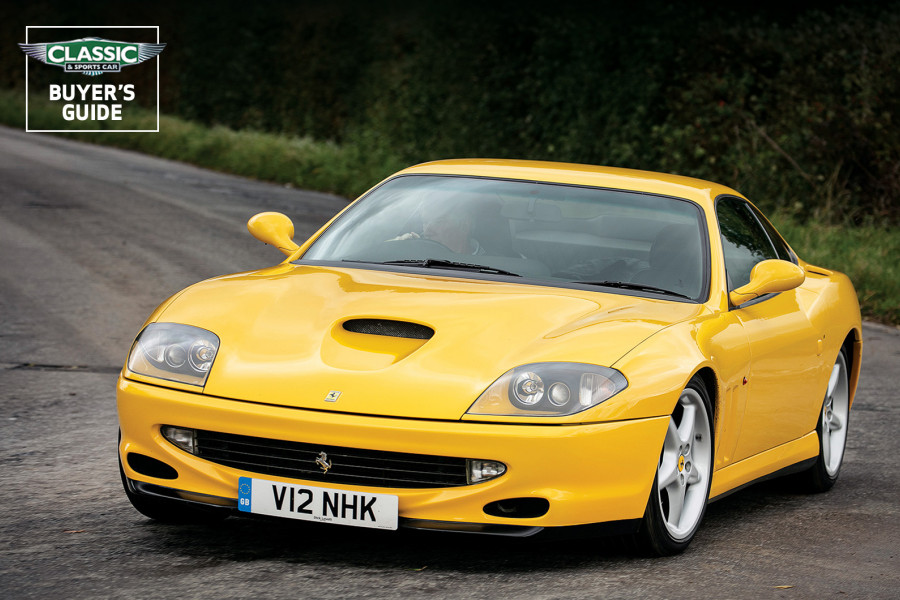However, because the GTS was only made until the 275GTB/4 arrived in 1966, it never (officially – see below) benefited from the four-cam car’s engine and powertrain revisions, which we’ll come to shortly.
Praise be, the sun is shining today, so we’re in full dolce vita mode, with the Spider’s fabric hood tucked away neatly beneath its tonneau.
Ferrari’s vocal V12 in the 275GTS produces 260bhp
Inside, the car’s key controls are located as per the Berlinetta versions, but, other than the main instrument binnacle, the dashboard has a different design and layout, with switches and heater sliders scattered around and beneath the steering column.
As already mentioned, the exhaust system of ‘our’ GTS appears to be almost unsilenced, so even at regular throttle openings the V12’s dulcet tones swim around you in the open cabin (along with anything else that isn’t well tethered).
The Spider’s set-up feels softer, with more roll through bends and pitch under braking, but we’re only talking incremental amounts versus the GTBs: essentially, the 275’s base dynamics have been preserved.
The more pillowy ride does, though, appear to minimise scuttle and column shake, which are more than acceptable for a near-60-year-old Italian convertible.
‘The pillowy ride seems to minimise scuttle shake, which remains more than acceptable for a near-60-year-old convertible’
Which brings us to the Ferrari 275GTB/4.
Unveiled in Paris two years after the GTB, in 1966, the GTB/4 was Ferrari’s replacement as its main offering in the high-performance arena until the 365GTB/4 ‘Daytona’ arrived in 1968.
Almost indistinguishable from the 275GTB externally, the GTB/4’s only visual giveaway was a subtly raised centre section along its bonnet.
Beneath the skin, though, the changes were far more radical and undoubtedly put in place to make the 275GTB/4 into a running testbed for the upcoming Daytona, 275-based prototypes of which had already been planned.
The Ferrari 275GTB/4 has the most linear power delivery
The addition of another overhead camshaft per cylinder bank was the headline improvement, justifying a new ‘226’ engine code.
Each pair of cams was driven by a central gear running on needle-roller bearings from a shaft mounted on the front face of the cylinder head.
Compared with the earlier engine, the valve angle changed from 57° to 54°, which improved gas flow and narrowed each cylinder head sufficiently to allow more freedom with the design of the inlet tract.
A dry sump was also introduced, which accommodated a more compact crankcase, housing two scavenge pumps, with the main supply coming from a two-gallon reservoir.
The Ferrari 275GTB/4 has a higher driving position than the earlier cars
Finally, the previously optional six-Weber set-up (40DCN17s on this car) was standardised.
These significant revisions raised output by 20bhp to 300bhp, produced at 8000rpm, and maximum torque from 188lb ft to 217lb ft, now peaking 500rpm higher, at 6000rpm.
Lifting the 275’s headline numbers, however, was more about keeping up in the mid-’60s horsepower race, with rival Lamborghini having already unveiled its 345bhp V12 Miura prototype at Geneva.
In reality, many Ferrari 275GTB owners had bemoaned the passing of the 250’s live axle, which they believed offered more precise handling.
Heuer clocks in the Ferrari 275GTB/4’s cabin
In response, Ferrari developed a more rigid structure for the drivetrain, introducing a 75mm-diameter torque tube around the propshaft, in effect creating a solid link between the engine and the transaxle, each of which was rubber mounted at two points to the chassis.
The 275GTB/4 with us illustrates perfectly the progress made from the GTB.
Completed in May 1967 but not registered in the UK until January ’69, the car, wearing optional Borrani wires, has been owned from new by the same family (which also owns the other two here).
Despite its extra weight and, in theory, lower power output than our highly specified GTB, the four-cam feels instantly more biddable.
‘Freed from the gluey viscosity of its cold lubricant, the Ferrari’s V12 is more alert and responds cleanly to throttle inputs’
Other than sitting slightly higher in a leather-trimmed seat, clipped in with the car’s original, airline-style Irvin seatbelt, the cabin is much the same as that of the earlier car.
But as soon as you delve into the four-cam’s reserves, the differences are manifest.
Performance is stronger and more linear in the low-to-mid-range, albeit accompanied by a more subdued bellow from the V12 (perhaps down to the steel body’s acoustics); with a stronger connection between the engine and the transmission, changing gears becomes a more fluid action, too.
The quad-cam Ferrari 275GTB/4 has 300bhp
Throttle response is even better than in the other two Ferraris and it goads you into pushing the performance envelope.
The dampers and springs on this beautifully preserved car are due for replacement, so broken surfaces in corners upset its composure a little, but overall it feels even more stable and slightly less pointy than the GTB through fast twisties.
That may in part be due to the additional positive camber this car runs (contrary to factory recommendations), along with the benefits of the drivetrain’s more secure location.
Either way, it’s the most confidence-inspiring of our trio.
Pininfarina styled both the Spider and GTB/4, but the two differ somewhat beyond the obvious roof removal
As my guide in the lead GTS, with his intimate knowledge of both these roads and the cars, continues to build speed, I’m (just) keeping pace and wondering if this is perhaps one of the best drives of my life…
It’s such a shame that the 275 – in Berlinetta guise, at least – is overshadowed by the undoubtedly more glamorous models that bookended its short, four-year life.
It was a technological breakthough, but Ferrari ownership then was, as it is now, as much about aesthetics as driveability.
Proof? The Ferrari 275GTB/4 that, with a sleek Leonardo Fioravanti body and 4.4-litre engine, morphed into the now canonised 365GTB/4 Daytona.
Images: Jayson Fong
Thanks to: Will Stone
Ferrari ‘NART’ Spyder: the other 275 drop-top
The Ferrari ‘NART’ Spyder raced in the 1967 12 Hours of Sebring © Getty
The 275GTS was only ever officially sold with the earlier two-cam V12, but Ferrari’s legendary US importer, Luigi Chinetti, was keen to have a more potent successor to the 250GT California, which had ceased production in 1963.
Chinetti secured the approval of Enzo Ferrari and ordered 25 open-top versions of the 275GTB/4 from Scaglietti, but poor sales led to only 10 cars being built between 1967 and ’68.
Known unofficially as the ‘NART’ Spyder, after Chinetti’s North American Racing Team, the first 275GTB/4S was entered in the 1967 12 Hours of Sebring, finishing 17th overall driven by Denise McCluggage and Marianne Rollo (above).
Road & Track magazine also tested an early car in September ’67, declaring it ‘the most satisfying sports car in the world’.
Boosted by a role in The Thomas Crown Affair, NART Spyders command high sums at auction: Aston Martin F1 boss Lawrence Stroll successfully bid $27.5m for a one-owner car at RM’s Monterey sale in 2013.
Factfile
Ferrari 275GTB
- Sold/number built 1964-‘66/450
- Construction multi-tubular steel chassis frame, steel or aluminium body
- Engine all-alloy, sohc-per-bank 3286cc 60° V12, three or six twin-choke Weber 40 carburettors
- Max power 280bhp @ 7600rpm
- Max torque 188lb ft @ 5500rpm
- Transmission five-speed manual, RWD
- Suspension independent, by unequal-length wishbones, coil springs, telescopic dampers, anti-roll bar f/r
- Steering worm and roller
- Brakes Girling ventilated discs, with servo
- Length 14ft 2in (4325mm)
- Width 5ft 8in (1725mm)
- Height 4ft 1in (1245mm)
- Wheelbase 7ft 10½in (2400mm)
- Weight 2425lb (1100kg, dry)
- 0-60mph 6.6 secs
- Top speed 160mph
- Mpg n/a
- Price new £5973 (1965)
- Price now £2-2.5m (long-nose, aluminium body)*
Ferrari 275GTS
(where different from GTB)
- Sold/number built 1964-’66/200
- Max power 260bhp @ 7000rpm
- Max torque n/a
- Weight 2469lb (1120kg, dry)
- 0-60mph 7.1 secs
- Top speed 150mph
- Price new £5973 (1965)
- Price now £1.2-1.5m*
Ferrari 275GTB/4
(where different from GTB)
- Sold/number built 1966-‘68/330
- Engine dohc-per-bank, six twin-choke Weber 40DCN17 carburettors
- Max power 300bhp @ 8000rpm
- Max torque 217lb ft @ 6000rpm
- 0-60mph 6.1 secs
- Top speed 166mph
- Price new £6515 (1967)
- Price now £2-3m*
*Prices correct at date of original publication
Enjoy more of the world’s best classic car content every month when you subscribe to C&SC – get our latest deals here
READ MORE
Ferrari Daytona Berlinetta, Spider and Competizione: kings of the road
Aston Martin DB5 vs Mercedes-Benz 300SL vs Ferrari 275GTB: million dollar babies
Ford Mustang at 60: Route 66 in the original pony car
Simon Hucknall
Simon Hucknall is a senior contributor to Classic & Sports Car

